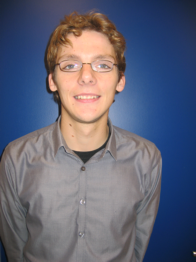Structural and functional insights into interactions of oligomeric α-synuclein with lipid membranes
Promotion date: 26. November 2009
Promotor: Prof. Dr. Vinod Subramaniam
| The neuronal protein α-synuclein is considered to play a pivotal role in the onset and progression of Parkinson’s disease. In this thesis the way how oligomeric α-synuclein interacts with lipid membranes, is elucidated. The research resulted in a much better understanding of the interaction. Data indicate that membrane instability is an important factor. In addition to the amyloid pore hypothesis, many alternative promising models for the mechanistic aspects of the disease exist. It enforces the statement that determining the mechanisms underlying Parkinson’s disease, are extremely complex. |
What is the relation of your work with Mesa+ and nanotechnology?
My connection with Mesa+, is mainly based on organizational aspects. However, essential research aspects were certainly in the nano-range. To study the structural basis for toxicity of the affected protein - which in my hypotheses is essential – it was necessary to measure the interaction of spherical protein particles sized 8 nm, with lipid membranes. I have extensively used the facilities in the central materials analysis laboratory, that are current in Mesa+ research. Also, I used optical methods that are more common in biophysics than in classical nanotechnology.
How did you come across your research topic?
Basically, professor Vinod Subramaniam took the protein with him, when accepting his position in Twente. The research was financed directly by the University of Twente and was also supported by the NanoNed programme. Although brightening results are obtained, regarding the mechanisms playing a role in Parkinson’s disease, it is hard to formulate a definite outcome yet.
The research topic stays important in Twente as well. A new TOP-grant has just been accepted, so three graduates will continue the experiments.
Did your view on scientific research, alter in the last four years?
Yes, I guess so. Scientific research seems to be a rational and understandable process. Nevertheless, a fair amount of opportunism plays a necessary role as well, under the stream of strong visions some leading experts really do have. They are the ones collecting the research grants successfully. That is the most logical way to act, of course. However, also more adventurous researchers must be able to benefit from time to time.
What, in your opinion, is important for Mesa+ in the future?
I really enjoyed being part of the annual Mesa+ days. I think it is wise to organise this kind of multidisciplinary institute-meetings, crossing faculties. It is very lively, can lead to new ideas, and you meet interesting people to talk to or even to collaborate with.
What are your future plans?
I don’t fancy an academic career. One has to have a strong vision, do a lot of investment in follow-up research as a post-doc and, most of all, one has to be very creative in collecting new funds, again and again.
To find a job in industry is hard these days. Originally I am a physicist, and now I am more multidisciplinary oriented. Perhaps a job as clinical physicist is both interesting and a feasible way to further develop my skills.

